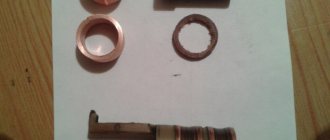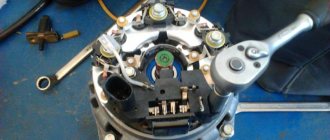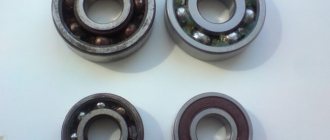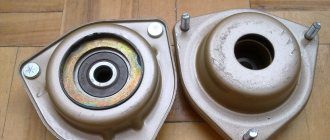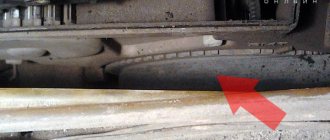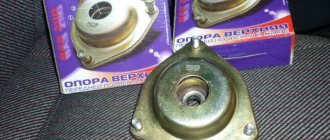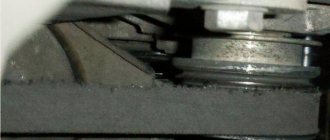The generator bearings ensure easy rotation of the rotor around its own axis. Since they have to constantly experience quite a lot of stress, they wear out over time. Which, in turn, will first lead to a hum, and then failure of the unit. In this case, they need to be replaced with new ones. Therefore, motorists have a question: “ What bearings are on the VAZ 2110 generator??».
What bearings are on the VAZ 2110 generator?
The “tens” generator has two bearings – a larger front one and a smaller rear one. In this case, it is the front one that most often requires replacement, since it experiences more significant loads. But, over time, you also have to change the rear one, although it is better if you change it, then both at once. They can be sold as a set or separately. New bearings are selected depending on its size.
Bearing sizes for generator
The bearings of the VAZ 2110 generator have different sizes depending on the year of manufacture of the car, as well as whether it is carburetor or injection. They differ in diameter for the landing shaft.
| Dimensions of original VAZ 2110 bearings | ||||
| Year of manufacture of the car | Bearing | vendor code | Catalog number | Dimensions, internal diameter / external diameter / width, mm |
| Before 2001, carburetor | Front | 180303 | 6302 | 15×42×13 |
| Rear | 80202 | 6202 | 15×35×11 | |
| After 2001, injector | Front | 180302 | 6303 | 17×47×14 |
| Rear | 80203 | 6203 | 17×40×12 | |
Sedans of the first years ( before 2001 ), which are most often equipped with a carburetor, have old-style generators. In such a generator, the front bearing has dimensions of 15×42×13 mm, and the rear bearing – 15×35×11 mm. The first has catalog number 6302 and original article number 180303, the second has number 6202 and factory article 80202. Foreign-made parts will be marked 6302-2RS and 6202-2RS, respectively.
Bearing 6202-2RS
Bearing 6302-2RS
If the car is fuel-injected and manufactured after 2001 , then these parameters will be different. The front bearing of the VAZ 2110 generator (number - 6303, article - 180302) has dimensions - 17 × 47 × 14 mm. And the rear bearing with number 6203 and article 80203 is 17x40x12 mm. Their foreign analogues are marked: front - 6303-2RS and rear - 6203-2RS.
Bearing 6303-2RS
Bearing 6203-2RS
The numbers and sizes of bearings for the “tenth” generator may differ if another unit was installed instead of the standard one. When there is a generator made by Denso or BATE, then they, like the new KATEK model, will always have 303 and 203 bearings. However, if, for example, Bosch 14V 53-98A 8200 43 81 48 0124 415 038 is installed, then bearings 6303-2RS are installed - front, with a size of 15 × 35 × 14 and 6003-2RS - rear (analogue of the domestic 180103), the size of which is 17 ×35×10. These same bearings can also be found in other imported generators, which are installed mainly on budget foreign cars. However, there are options where the rear bearing costs 6000-2RS, and the front bearing costs 6203-2RS, or there can also be 62202-2RS at the rear (size 15x35x14) and 6302-2RS at the front.
Imported or domestic
Belarusian 90-amp BATE and Japanese Denso generators have bearings of the same size.
Imported analogues of bearings have a slightly different designation, namely:
Most 80-amp generators have bearings of similar sizes, at least this applies to domestic ones. If the generator has already been replaced before you, then you may be faced with the fact that a generator from a different manufacturer is installed and the bearings are of different sizes. Depending on the generator manufacturer, bearings of other sizes are sometimes found, for example, in the fairly common Bosch 14V 53-98A 0124 415 038 generator, bearings 6003-2RS (rear) are installed, the dimensions of which are 17 × 35 × 10 and 6303-2RS (front) , respectively, 15×35×14. The same bearings can be found in other imported generators. However, there are options where the rear bearing is designated as 6000-2RS, and the front bearing – 6203-2RS.
In order to accurately determine the dimensions of the bearing, it will have to be removed. If the markings on the bearing are not visible, then it is best to turn to professionals (you should not trust a caliper).
If you have decided on the size of the bearing, then to the repeated question “What bearings are on the VAZ-2110?” The answer suggests itself - original!
The quality of bearings varies from manufacturer to manufacturer; some prefer to install bearings from domestic manufacturers on their generators, while others prefer imported ones. When repairing a generator, everyone decides this issue for themselves, but after listening to numerous tips, some car enthusiasts are inclined to choose imported ones. If you focus on price-quality ratio, many experts recommend DAS LAGER Germany. But there are other suppliers of quality bearings: the French company SNR; FAG is one of the leading companies in Germany; NSK is another major bearing manufacturer from Japan; NTN – Japan; Kouo - part of the Toyota concern of Japan; Kraft or BOSCH.
Which bearings are better to install?
As a rule, KATEK brand generators were installed on cars of this model from the factory. It may also be suitable for spare parts from some other domestic and foreign manufacturers. It is not recommended to use original bearings from the Samara and Volzhsky plants (VBF and VPZ), as well as Chinese ones, due to poor lubrication and short service life. Products from German brands DAS LAGER Germany and FAG, French brands SNR, Japanese brands NSK, NTN and Kouo, as well as Polish Craft are considered to be of good quality.
Price of bearings for VAZ 2110 generator
The price of a VAZ 2110 generator bearing is very low. It starts from about 100 rubles for the rear and from 150 rubles for the front. Here a lot depends on the manufacturer of the parts. Russian-made spare parts are considered the cheapest. Products of foreign brands are more expensive, sometimes twice as expensive.
Parts Specifications
To purchase new parts, you need to know which bearings are specifically installed in your unit in order to avoid mistakes. The VAZ-2110 generator has 2 supporting elements: front and rear. Their markings vary depending on the year of manufacture:
- in units produced in recent years, the rear part is marked 6203, the front - 6303;
- in older versions the number is slightly different - 6202 and 6302, respectively.
The bearing cages are sealed on both sides with plastic caps, which can be removed to add lubricant if necessary. The overall and internal dimensions of the rotating parts are the same for any marking; their exact values are indicated in the table.
| Bearing size | width, mm | by outer diameter, mm | by internal diameter, mm | Catalog number |
| Front | 14 | 47 | 17 | 180202 |
| Rear | 11 | 35 | 15 | 24940220 |
As a lubricating filler for cages, you can use thick lubricant “Litol-24” or another intended for rolling bearings. It is easy to identify the manufacturer by the additional symbols on the labeling.
The most popular parts of Russian production are from the following enterprises:
- Samara plant, marking - SPZ-4;
- Vologda plant - 23GPZ;
- Saratov plant - 3GPP.
Also, quite often, motorists install 2110 generator bearings from the Koyo, Kraft and LSA brands.
It is strictly not recommended to install elements without inscriptions and markings, manufactured in an unknown location, most often in China.
You may run into trouble with such parts quite soon due to the poor quality of the products.
Signs of bearing failure and diagnosis
You can understand that the bearing in the generator has failed by the following characteristic signs:
- when the engine is running, a hum, whistle or grinding noise is heard from under the hood;
- the generator is hot to the touch when the engine is running or immediately after stopping it;
- The device pulley rotates.
In addition, some other symptoms may indicate this problem. And the ones mentioned above do not always indicate a bearing malfunction.
Comparison of worn bearings (left) with new ones (right)
The bearings in the generator can wear out due to time, lack of lubrication or poor quality, and also due to too much belt tension. The latter is usually typical for front bearings.
In order to accurately verify the failure of this element, you need to carry out simple diagnostics. Simply remove the alternator belt and start the engine.
If the extraneous sounds disappear, it means that the bearing is faulty. With the engine off, you can slightly shake the generator up and down by grabbing its pulley. In this case, no backlash should be felt. You can find out which bearing should be replaced after disassembling and inspecting all the elements. It's often better to buy a kit right away just in case.
Methods for checking the unit
For timely detection of bearing failures, there is no better way than a preventive inspection and checking the rotation of the rotor shaft. To do this, it is not necessary to specially disassemble the unit if you periodically replace the generator drive belt with your own hands. During this replacement, shaft rotation is checked in the following ways:
- grab the pulley with your hand and try to swing it perpendicular to the axis to determine the play;
- actively rotate the pulley in different directions.
If you feel play by hand or the shaft rotates with jamming and noise, then replacing the bearings of the VAZ-2110 generator is inevitable. Another sign of wear on parts is the appearance of noise in the form of a humming sound coming from the unit when the engine is running. In this case, it is necessary to localize the malfunction, since a rotating element of another unit located nearby may be humming: a pump or a timing belt tension roller.
It is not difficult to determine where the noise originates: you need to remove the generator drive belt and start the engine for a couple of minutes. If the hum disappears when idling, it means that its source was the elements of the VAZ-2112 generator, and the pump and roller are in good condition. In the same way, the operation of the bearing of the VAZ-2114 generator and any other model of the “tenth” family is checked.
How to reduce noise without tuning
If you'd rather avoid making any changes to the generator itself, there are still ways to muffle the sound.
- Installation as far as possible
It is so simple. The further you go, the less likely you are to hear it, so use longer extension cords if possible.
- Create a Soundproof Box
Assembling a generator box not only prevents sound from spreading, but can also serve as a space to store the generator outdoors.
Remember that fuel-burning generators require adequate ventilation to prevent dangerous levels of carbon monoxide from building up. Fire retardant insulation material is a good material for this.
- Install sound deflectors
Sound deflectors are solid materials that reflect sound waves in a different direction. In some cases they are used to create a more direct line towards you, but in this case you obviously want to adjust the deflectors so that they move away from you and your home.
- Install the generator on rubber
Some noise simply comes from vibrations, so if the alternator shakes less, that can also reduce noise. A simple rubber mat under the generator is enough to reduce vibration or purchase a special anti-vibration mat.
Alternatively, buy rubber feet
The best option is to use several noise reduction methods at the same time. The generator will never be completely silent, but these tricks can reduce the uncomfortable noise level.
Sequencing
- The positive terminal of the car battery is disconnected.
- Now it is necessary to remove the timing belt; to do this, use a 13-size open-end wrench to unscrew the fastening nut, after which the fixing bolt is unscrewed from the tensioner with a 10-size open-end wrench.
The arrow indicates the location of the generator tensioner mounting bolt.
Removing the lower generator mount
It is more convenient to unscrew the generator pulley in a vice
This is what a VAZ 2110 generator looks like without a brush holder
Pressing out the front bearing of a VAZ 2110 using a mandrel should be done without extra effort
The rear bearing of the generator will only be accessible after removing the rotor
When is it necessary to change?
If a car generator begins to creak and howl during operation, this is the main sign that the bearings urgently need to be replaced . Howling, as a rule, occurs due to the lack of lubrication in the separators of these parts. Alternatively, the bearing cage may simply fail due to wear or fatigue stress. There is one nuance here that should definitely be mentioned. Sometimes on a VAZ 2110, what is heard from the generator area is not a howl, but a thin, barely audible creak, which the car owner can mistake for the creak of a failed bearing. But most often it’s the pump creaking or the sound coming from the pulley on the timing belt. To understand that it is the generator bearing that is creaking, you should remove the belt. If the sound does not disappear, then the problem is in the bearings.
ENGINE SIZE
Typically, the larger the engine, the louder it runs, which also means that larger generators can make more noise than smaller ones. This is why, for example, a heavy duty 8000 watt portable generator has a higher decibel rating than a 2000 watt version in the same range.
However, there are exceptions. The Home Standby model is very powerful, but it comes with noise-canceling technology so it can be installed very close to your home without being too noticeable.
There are also inverter hybrids that have a higher capacity than traditional open frame inverters, making it lighter. This is a good alternative to regular portable generators if you are concerned about decibel levels.
Installing new items
Before replacing worn VAZ-2110 bearings on your own, it doesn’t hurt to check the presence of lubricant in the newly purchased parts. To do this, you need to pry up and remove one of the plastic protective covers of the separator with a sharp object. If necessary, add lubricant and replace the cover. Then you can start replacing, for which you will need a standard set of keys and tools available to every business car enthusiast.
It is most convenient to dismantle the rear bearing of the generator using a puller, but if this is not available, a regular open-end wrench measuring 22-27 mm will do.
It is better to remove the generator from the car from the inspection ditch in the following sequence:
- Disconnect the battery and disconnect the wires from the contacts of the unit by unscrewing the fastening nuts with a 10 mm wrench.
- Unscrew the belt tensioner bolt, loosen it and remove it from the generator pulley. Remove the tensioner bar.
- Using a 13 mm wrench, loosen and unscrew the nut of the lower support of the unit. Remove the bolt and remove the generator from the car.
According to the manufacturer’s recommendation, replacing the VAZ-Ten generator bearing located at the front should be carried out together with the cover into which it is pressed. But there is no point in changing the cover if it is in good condition, which should be ensured before disassembling. And such a replacement will cost more.
The main thing that needs to be done carefully when performing further work is to remove the old bearings. The procedure is as follows:
- Place marks on the body and covers of the unit to indicate the relative positions of the parts. Unscrew the bolts holding the covers together with the body (4 pcs.).
- Use a flat-head screwdriver to separate the housing parts. Remove the back cover along with the winding.
- The front bearing is knocked out of the cover through a round insert. This must be done carefully so that the lid does not crack, otherwise it will have to be replaced.
- Remove the rear bearing using a puller or an open-end wrench inserted vertically at one end between the part and the rotor. Tapping the key with a hammer and moving it around the axis, gradually knock down the bearing.
New elements are pressed into place with a hammer using old bearings as guides. Then the unit is assembled and installed on the car.
Source
Useful tips
During operation, moisture gets onto the generator, so when dismantling and disassembling, information on how to lubricate the threaded connections is relevant. For this purpose, a WD-40 spray has been created, which is used to treat detachable connections 5 - 7 minutes before unscrewing.
Before replacing bearings, you should inspect the components:
- collector rings, brushes and brush holders;
- diode bridge and voltage regulator;
- stator winding and armature magnets.
Grease LM50
In second place is the SKF lubricant modification LGWA 2 worth 950 rubles, in the third position of the ranking is the EP 2 product from Gazpromneft (issue price 175 rubles).
Thus, it is better to change the front bearing of the generator together with the cover of the same name. A puller is required to remove the rear bearing. However, all repair operations can be performed independently in the garage.
Replacement
To replace it, you will need to remove the generator from the car and some plumbing tools. It would also be a good idea to have a generator bearing puller. Having all the necessary tools, you can handle the job with basic mechanical knowledge.
Puller
The puller greatly facilitates bearing replacement work, saving time, effort and nerves. This device is a faithful assistant not only when working with a generator, but also with other car parts.
It consists of claws and a thrust bolt. There are a large number of different pullers, they are: two-jaw and three-jaw. In our case, when working with a VAZ 2110 generator, it is best to use a two-jaw one; it is the most compact and convenient to dismantle the bearing.
Its cost varies from 200 to 1000 rubles, depending on the quality of the part.
Necessary tool
The tools you will need to complete the work are presented below:
- Ratchet;
- 13mm, 10mm key;
- 21mm head;
- 8 mm hexagon;
- Gas key;
- Powerful screwdriver “+”;
- Hammer;
- Puller;
- Punch;
- WD-40 (lubricant)
- Rags;
- Marker;
Stages of work
1. Disconnect the negative terminal from the battery. We unscrew the wires on the generator with a 10mm wrench and remove the generator excitation chip.
2. We remove the generator from the car. To do this, unscrew the generator belt tension bolt and remove the belt, unscrew the generator from the mounts and remove it from the car. Be careful not to lose the rubber bushing and washers when removing the lower mounting bolt.
3. Let's start disassembling. Remove the plastic cover of the diode bridge by bending the three latches. Unscrew the two screws securing the brushes to the body and disconnect the connector from the brushes. We mark the alignment of the covers with a marker so that in the future we can assemble everything correctly.
4. Using a screwdriver, unscrew the screws of the ends of the generator winding from the diode bridge and bend them. Unscrew the screw securing the capacitor and separate the diode bridge from the generator.
5. We unscrew the generator pulley with a 21 mm socket, holding it with a gas wrench and holding the rotor shaft with an 8 mm hexagon. We take out the generator pulley and thrust washer.
6. Unscrew the 4 bolts of the cover and remove it along with the stator winding.
7. We take out the back cover by pressing the manifold with our fingers and pull the cover towards ourselves, remove the plastic bearing bushing.
8. Remove the bearings using a puller.
We assemble the generator in the reverse order.
Reasons for failure
There are many reasons for bearing failure, but there are several main reasons, which are discussed below.
Wear
Wear is a typical cause of bearing failure, since the number of revolutions of the generator rotor is huge over the Nth period of time. Consequently, the lubricant in bearings under the influence of high temperatures loses its properties and the bearing ceases to receive the required slip coefficient, which causes heating and increased clearances in the ball part of the bearing.
Belt tension
Excessive tension on the alternator belt greatly affects the life of its bearings. It is necessary to tension the belt correctly, observing all norms. The generator belt should bend under the influence of 10 kg. by 5-7 mm.
